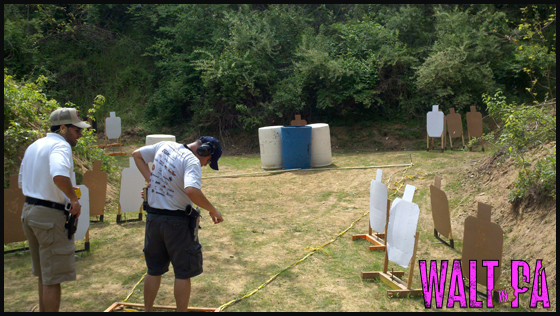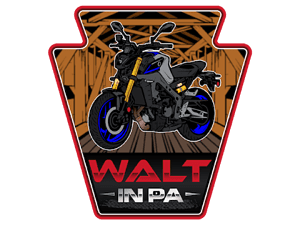While being the first shooter on the first stage of the day has its challenges, there are some benefits as well. For starters, the remainder of the day will have me buried deep in the shooter rotation. Second, when you tank a stage as hard as I did Stage 5 (Confusion), it is easy to forget by the time you’re up to shoot on the following stage.

Ever since my rocky start to the USPSA Season, I’ve been making a point to clear my mind after each stage. I learned my lesson that dwelling on your past stage performance, especially if it is bad, can lean to mental challenges when it is time to perform again. As a result, I have been stepping up to the firing line with a clear mind, and it has done wonders for my shooting.
As I stepped onto Stage 6 (Lucky 13), I smiled and thought ‘This looks like fun!’ The rear pistol pit that this stage was situated on was recently expanded. It was cut deeper into the hillside and has a unique bell shape towards the rear of the pit, which also happens to be uphill of the start position.
Stages on this pit tend to be condensed with clusters of tight targets near the starting position and flared out at the top. Stages tend to start out fast and get slower as you make your way uphill, firing to your left and right.
The Plan:
To begin Lucky 13, I wanted to have my hips squared up with a pair of targets on my right. Upon hearing the start signal, I would draw my gun and engage the furthest of the two targets then transition to the closer target. I would turn left and engage the closer target, then engage the further target as I left the start position, taking it on the move.
With eight rounds fired, I would reload my gun while I moved into the next position. As I moved uphill and towards the left side of the pit, I would approach a low target situated behind a barrel. My thought process was that I should not worry about that target right away and instead trust my abilities and engage a farther target while moving into position. Once the farther target was engaged, I could then transition to the low target before setting my feet to transition back out to the far targets.
The far array had a single target wide open (which is why I felt comfortable shooting it on the move), a hard cover target beside it (which I had no interest in shooting on the move) and one last open target next to that. Once I had my feet set, I would engage the hard cover target and the open target next to it.
My next move was to the middle of the stage. While moving into position, I would reload one final time. Once my feet were set, I would engage a low target tucked behind a barrel, transition to a target further down range, then turn my hips to the right. The last array consisted of three paper targets, which I felt comfortable engaging from the position I was standing in.
After The Buzzer:
When the shot timer sounded, I drew my gun and began to execute my plan. I engaged the far target then transitioned to the near target. My shots weren’t as fast or as smooth as I would have liked, but sometimes it takes me a stage or two to get warmed up.
I twisted to my left and engaged the near target, then engaged the far target as I began moving downrange. I reloaded my gun as I ran past the last target and was pressed back out to engage the next array. I put two rounds on the far target as I baby-stepped my way into position, then transitioned to the low target behind a barrel. Due to the way the target was situated, I put two rounds into to the head and nearly paniked. As I pressed the trigger to break the second shot, I realized that the head of the target was flopping around due to the gasses escaping my muzzle. In my mind, I prayed that the head wasn’t bent out of position when I broke the second shot.
Getting caught up in the speed of the stage, I didn’t stick around to look for holes in my target and transitioned to the next target in the array. I put two well aimed shots in between the hard cover and transitioned to the last target in the array. There was a penalty target partially hiding this one, so I put two more well aimed shots into it before moving to the next position.
I reloaded my gun on the move and took two quick shots to the head of the low target infront of me. Just like the first close range, low target, I watched the head flop around and cursed as I transited back up to a far target. I turned to my right, squared my hips, and fired six rounds into the last three targets to end the stage.
Stage 6 at the April 2012 Southern Chester USPSA Match
Results:
When the range was declared safe, my concern shifted to the two low targets that I made head shots on. My fear was that my first round was on target but that the escaping gasses from my muzzle blew the head out of position for the second shot, giving me a miss. As it turns out, I was fine in that regard and had no misses on the stage.
I completed the stage in 20.78 seconds with 20 A’s, 1 B, and 5 C’s, earning me 7th place in Production Division. I scored 118 out of a possible 130 points, giving me a point percentage of 91%. My Hit Factor was 5.6785. Despite feeling a little clunky in my shooting, I was happy with my results on the stage.
2 thoughts on “USPSA at Southern Chester – Stage 6”
Comments are closed.
Recent Posts
From Group Ride Roasts to Real Life: My YouTube Channel Update
Well, my lovelies (I realize that sounds weird but at this point I need to lean into it), it's time for some real talk about where I've been and what's been happening behind the scenes at Walt in...
Reconnecting with friends, exploring scenic Pennsylvania back roads, and enjoying the simple pleasure of two wheels Getting the Band Back Together Today was a pretty special day in the...

Why did you start on the 2nd target on the right instead of the near target? I would have thought that would have given you a shorter transition to T3.
Also you said in the other video that you liked going from right to left… couldn’t you have gone left to right on the 1st for and still gone left to right on the far targets?
BTW your reloads are pretty smooth!
My thought process was that if I started on the far target, on the right, then transitioned to the near target, the transition would be easier/faster to the near target on the left. I knew that I wanted to take the far left target on the move, so I saved that for last.
I suppose I could have started near right, transitioned to near left, then tried to take bath far targets on the move, but I didn’t want to risk getting too close to breaking the 180 degree plane, or having to stop before I went past it.
Shooting on the move, towards my left, feels more natural. That is why I saved the far left target for last.
Thanks, I try to work in plenty of reloads whenever I do dry-fire practice (which I don’t do often enough). I even made a practice mini-stage to hammer reloads because I was having a lot of trouble with them.
Here is that practice stage if you’d like to check it out
http://www.waltinpa.com/2012/03/11/uspsa-practice-session-to-too-and-two/
Thanks for the comment